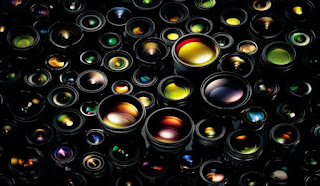Lenses
Lenses are transmissive optical devices which use refraction to focus or
disperse a light beam. A simple lens is made by a single piece of transparent
material, these simple lenses can be arranged along a common axis to construct
a compound lens. Both glass and plastic can be used to make lenses. By reading
this article, you will know more information about lenses i.e. their
construction, types and uses.
Construction of simple lenses
Lenses have two surfaces which are spherical in most cases. There are
three forms of these surfaces; convex, concave or planar. The axis of the lens
is a line which connects the centers of the two surfaces together.
There are lenses having surfaces with two different curvature radii which
called sphero-cylindrical lenses. Eyeglass lenses is an example of this type of
lenses which are used to correct astigmatism in eyes.
There's
another type of lenses which has neither cylindrical nor spherical curvature in
one or both of its surfaces called aspheric lenses. These lenses are expensive
and difficult to be produced than other standard simple lenses. Images which
have less aberration can be produced using these types of complicated lenses.
Types of simple lenses
There are many types of simple lenses which are classified according to
the type of curvature of their both optical surfaces. Lenses are classified as
shown below:
·
Biconvex lens: This type of
lenses has two convex surfaces. It's called equiconvex lens if the curvature radius
of its two surfaces is the same.
·
Biconcave lens: This type of
lenses has two concave surfaces.
·
Plano-convex lens: This type of
lenses has two different surfaces; one surface is convex and the other one is
flat.
·
Plano-concave lens: one of its
two surfaces is concave and the other one is flat.
·
Convex-concave lens: it's also
called meniscus lens which one of its surfaces is convex and the other surface
is concave. It's used commonly in corrective lenses.
The lens can be classified as positive or converging lens if it is
biconvex or plano-convex and the beam of light which
passes through the lens will converge to a point or a spot behind the lens.
The focal lens (f) equals to the distance between the lens and the spot.
The lens can be classified as negative or
diverging lens if it is biconcave or Plano-concave and the beam of light which
passes through the lens will diverge and spread. This beam appears as a point
in front of the lens. The focal lens (f) equals to the distance between the
lens and this point. It will be negative.
Convex-concave lens can be also classified as positive or negative. It's
positive when having a steeper convex surface and it's thicker at the center.
It's negative when having a steeper concave surface and it's thinner at the
center.
Uses of Lenses
ü The magnifying glass consists of a single convex lens which is mounted
by using a frame having a stand.
ü Lenses are mainly used in the correction of visual impairments such as
astigmatism and myopia.
ü Lenses are widely used in imagining systems which used for the
production of visual images; cameras, microscopes and projectors.
ü Lenses are used for the production of energy by concentrating the solar
energy on photovoltaic cells.
ü Lenses are used by radar systems for the refraction of electromagnetic
radiation.











ليست هناك تعليقات:
إرسال تعليق